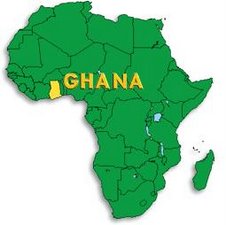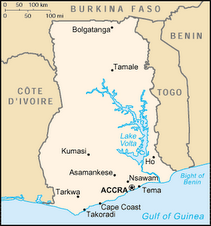Saturday, December 26, 2009
The day after Christmas
This day off found me rising at the usual 5:30 AM, breakfasting on yams and onions, muffins, fresh orange juice and a pau pau, which I purchased with haggling yesterday. I studied Dagbani for an hour by listening to conversations that I had recorded while in taxis traveling to and from work. It is fun to use the small hand-held recorder I recently purchased as some passengers are not familiar with recorders nor have they ever heard their own recorded voice. They also roar over my atrocious pronunciation. I laugh too when I listen. Just this month I have been able to have a simple conversation with a familiar topic. It gives me a thrill as language learning is difficult with my moderate hearing loss. Afterward, I placed cuttings from flowering bushes in water and compost soil and following that, I spent an hour studying a patient’s disease. Today, the disease was hydrocephalus and Arnold-Chiari malformation, because I lost a three-month old Wednesday with this condition. The child had a progressively enlarging head and dyspnea from bilateral vocal cord paralysis when he presented with cerebral malaria, seizures and died. A pediatric fiberoptic nasopharyngoscope was needed to examine this sick infant’s larynx. The adult scope was too wide to pass through her nose.
Lunch today consisted of a yam, string bean and carrot stew, diluted orange juice and a Christmas present of cashew nuts which Cyndy gave me yesterday. Then another gardening break. This time planting pau pau trees in the dry cement-like soil. Each side of the house now has a row of ten pau pau trees; the symmetry is pleasing. Time to treat myself to whatever I choose. This blog posting is being written because my friend and former medical school roommate mentioned on a call yesterday that there were no blog entries since November. Next on my agenda: taking an interactive aviation course online or looking up sites for my birthday-family vacation this March in Egypt. Hopefully the hospital will not call to disturb this Type A personality. I described my day after reading "Narrative of the Life of Frederick Douglas, an American Slave, Written by Himself." It is an excellent book and he could certainly give me a few lessons in writing. P.S. Corrective comments are appreciated.
Saturday, November 21, 2009
Steady but slow progress
Yesterday, a two-month old with shortness of breath, severe chest retractions and normal cry was referred and may have a congenital double aortic arch compressing his trachea. Laryngoscopy and bronchoscopy may help diagnose the cause of the child’s dyspnea. Hopefully the obstruction is due to a cyst of the larynx which I may be able to remove. If it is a vascular malformation, the cardiothoracic unit at Korli Bu in Accra may be able to correct it. However, a big problem is the family’s inability to pay the expenses of traveling and staying in Accra for the duration of the child’s treatment. Most families cannot afford these costs and the child will be brought back to the village to die.
With our Egyptian pathologist having returned home, proper patient care has deteriorated. A biopsy of a patient with laryngeal cancer was sent to another institution four weeks ago and still there is no report. His cancer is now inoperable. In the future, I will send the patient to have the biopsy and treatment at the other hospital until we have a working system here.
Tuesday, September 22, 2009
An exhausting, but successful week.
Twelve year old girl hit hit by a broken machine belt crushing her larynx and lacerating her pharynx.
This week was exhausting, but successful. Three patients presented with severe upper airway obstruction requiring emergency tracheostomies. The first patient had complete upper airway obstruction from a carcinoma of the larynx. Following his tracheostomy, his tracheostomy tube obstructed twice due to lack of humidity, suctioning and the use of too small a suction catheter. The second patient, a three-year boy had the wall of his house collapse on him during a heavy rain causing a concussion, orbital fracture and swollen tongue, which required an emergency tracheostomy. The third, a twelve-year old girl, had a crushed larynx caused when a machine belt broke hitting her flush in the anterior neck causing a thyroid cartilage fracture, separation of the true and false cords from the arytenoids and retropharyngeal air. Intubation was impossible and a cricothyrotomy was performed. The following morning the tracheostomy was properly repositioned and the larynx was sutured and stented back into its proper position. Sunday afternoon I slept five hours exhausted. I am in need of tracheostomy tubes of all sizes (as my own supply has dwindled), suction catheters, laryngeal stents and suction machines.
Monday, September 7, 2009
Return From a Visit to the US
Right mastoiditis for twenty-five years with hearing loss, facial paralysis and epidural abscess.
I recently returned to Ghana, accompanied by my wife, after a 45-day home emergency visit to the US because our son ruptured his appendix. He is now fine.
On arrival at the house in Tamale, the refrigerator, air conditioner and washing machine did not work. These problems have now been partially corrected.
The hospital staff warmly welcomed me back and asked about my son. There were no major failures in the ear, nose and throat clinic and our clinical conferences had continued successfully. During my first day back, a 40 year-old woman patient presented with a chronic ear infection, facial paralysis, sensorineural deafness and a frontal headache which required mastoid surgery. Her facial nerve was three times normal size, but intact and responded to stimulation, which indicates it may work again. During surgery, a tear in the middle fossa occurred requiring repair by the new neurosurgeon. The cautery machine did not coagulate, only cut, and this has to be looked into. More probes for the cautery and bits for the drill are needed for future cases.
There is a ton of work.
Thursday, July 2, 2009
a little girl's life saved

The child two days after removing the obstructing foreign body from her trachea.
Today we saved the life of a two and one half year old girl who aspirated a groundnut (peanut). She presented with severe shortness of breath, had a seizure, was brought to the operating room and the peanut blocking her trachea was removed. Several pieces of peanuts blocking her bronchi were also removed. The child is now well. All the equipment had been prepared for such an emergency and when the video camera did not work, the clinic's video camera was used successfully. Now, how to fix the broken video camera, which is essential in these small children.
Sunday, June 21, 2009
A positive outcome
 The removed seed.
The removed seed.This week we saved the life of a seven month old girl. Her mother was preparing a meal when the child, who was crawling on the ground, started choking and coughing. The following day the child was brought to the hospital in respiratory distress. The X-ray showed a large object in the pharynx. The nurse anesthetist did not want to do the child until after a blood transfusion and even afterward he refused to do the procedure that day. Arguments with both him and the general surgeon could not change their minds. Later that night a visiting anesthesiologist arrived and when the child began to fail, he readily agreed to help. A large "Baba" seed was extracted from the child's throat and the child improved. A month before we lost a 13 month old who aspirated a corn seed into the trachea. We originally referred this child to the capital city of Accra, but the child was brought to the village to die. We called the child back, but were unable to remove the corn seed which totally obstructed the trachea. I have to focus on the ones that are saved rather than despair over failures.
A post written last month, but now being posted
All items from the two containers have been distributed and now I can spend my time solely on otolaryngology. Some of the equipment worked for a while then stopped, so maintenance is a problem. After surgery the equipment does not always get back to us and missing pieces of equipment are a problem. The pieces show up eventually, but one cannot do some surgery confidently until the equipment is located and working again.
Monday, March 23, 2009
Follow up on the child with malnutrition after feeding
This photo was taken recently of the malnourished child described in the December 29 blog entry. The child was merely fed by the hospital giving food to the mother. No surgery has yet been done except for the removal of dead bone which simply fell out. He will have closure of the oral opening after he gains more weight. Everyone was happy here except the patient. When the child first presented, he did not have the strength to cry, sit up or stand by himself. He was so skinny. Notice how his color has improved, no longer an anemic paleness.
A tender handshake that I felt in my heart
Today a six year old, severely injured boy shook my hand in thanksgiving. This lad was in a traffic accident five days ago, split open his face and lost the front portion of his jaw. During surgery, his life was marginal. Now after five days he is alert and with everyone's care he will live. His reconstruction will be a major problem. In the same accident, his mother lost her ear and had to have her arm amputated. There are daily visits, dressing changes and frequent directions with the nurses. He understands English, but cannot speak because of the tracheostomy which was necessary to enable him to breath. Today, he persistently and with determination seeks out my hand. At first, I thought it was to prevent me from hurting him as we dressed his wounds. But, he shook my hand in thanks. I felt this tender handshake in my heart and it will be remembered my whole life.

